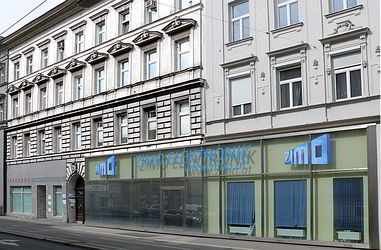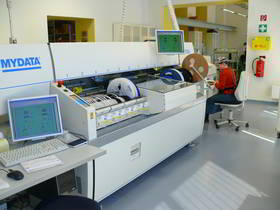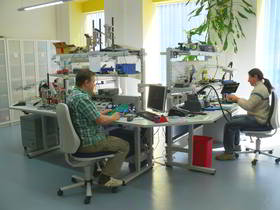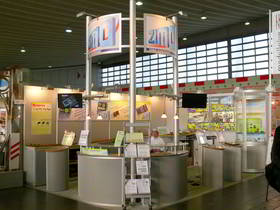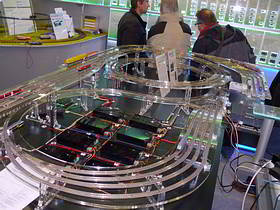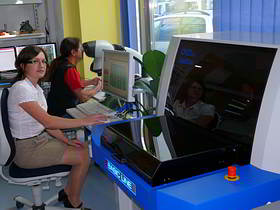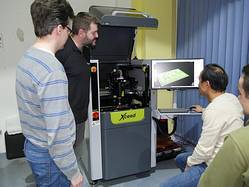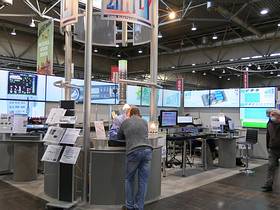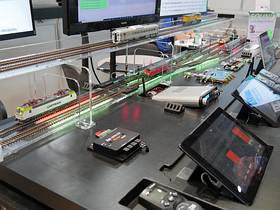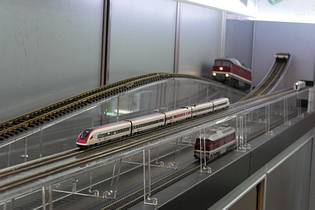- ZIMO Home
- Sound Design
- ZCS
- ZIMO GURU (FAQ)
- Links zu Partner Websites
Short story - 1978 to 2022
The technical milestones in ZIMO history |
||
| 1979 | the first ZIMO digital system (BGT-1, FP-2, FZE-2), at that time still called 'multi-train control', was delivered. The first ZIMO decoders, then ' vehicle receivers ', measured 45 x 30 x 20 mm. At that time the digital offer was very small: only one English system for 16 trains and 6 speed steps came almost simultaneously with ZIMO on the market. In comparison, the ZIMO system with 99 trains and 16 speed steps seemed almost exaggeratedly powerful. | |
| 1980 | This was followed by the first application of what was later referred to as 'signal-dependent train control', the integration of multiple train control and train protection technology, a specialty of all ZIMO digital systems that is still outstanding today. A decoder add-on module for This was followed by the first application of what was later referred to as 'signal-dependent train control', the integration of multiple train control and train protection technology, a specialty of all ZIMO digital systems that is still outstanding today. A decoder add-on module for load balance control was also developed; due to its dimensions, it could only be used for large-scale railways at that time. | |
| 1981 | the 'automation device' M500, the first version of the operational control, which enables block operation, routes, station control via pushbutton interlockings as in the original, appeared as part of the second system generation (M100, M200, M400). | |
| 1984 | With the M210, ZIMO has launched the first microprocessor-controlled cab on the market, whereby numerous additional performance features such as Loco Recall or Consisting could be realized. From now on, it was also possible to update the system by exchanging the EPROM. | |
| 1987 | the production of customer-specific signal boxes from original ÖBB control panels began, which together with the M5000 operating control unit formed a complete equipment for the train control technology. The largest interlocking consisted of 9000 panels with approx. 300 keys and 1500 LEDs. | |
| 1989 | The third system generation (M1000, M2000, M4000) brought, besides many other comfort features, the ZIMO loco number recognition, a function which could not be offered by any other digital system for the next 12 years. |
|
| 1990 | Decoders with high frequency (20 kHz) output stage could be manufactured (MX41); the world's first low-noise running (later often called ' silent running') combined with load balancing control. | |
| 1992 | the operational control units and push-button interlockings were replaced by the computer software 'STP' (E. Sperrer Software Entwicklung); the computer enables even more functionality in train control than before. 'Why to make with toys, if you can have the real example' was later an STP advertising statement, which shows quite aptly the principle difference of the method 'ZIMO and STP' compared to other system and software products | |
| 1994 | the fourth system generation (MX1, MX2, MX40) came: compact base unit, walk-around cabs, infrared cabs, miniaturization of vehicle receivers, switch receivers for installation in drive housings, etc. | |
| 1996 | was the year of the conversion to the standardized DCC data format, which was decisive for the company's continued existence. For some years multiprotocol devices were produced, which could control the 'old' ZIMO data format as well as DCC and MOTOROLA. From now on MOTOROLA was also supported in all other system generations besides DCC. | |
| 1998 | the product range is complete again, now for the standardized data format DCC. In particular, 'signal controlled speed influence' and loco number recognition are now also available for DCC. | |
| 2000 | The sixth system generation (base units MX1, MX1HS 'model 2000', vehicle receiver MX61 'model 2000', miniature decoder MX62, etc.) sets new standards in terms of performance, driving characteristics and functional diversity. | |
| 2002 | With the 'Economy Command Station' MX1EC, a product is launched on the market that enables the entry into ZIMO control technology at a previously unimaginable low price; this without limiting performance and application possibilities. | |
| 2004 | the standardised 'bi-directional communication' (RailCom) is prepared in relevant products such as command stations and decoders (commissioning can only take place after approval of the NMRA standard), thus opening up a range of extended application possibilities. Since autumn 2004 all ZIMO decoders are updateable, i.e. a new SW version can be loaded by the user himself - without opening the locomotive - with the help of the decoder update device. | |
| 2005 | the new cab MX31 with modern design and latest technology as well as the corresponding wireless cab MX31FU were introduced.. | |
| 2006 | several new products come onto the market, in particular the first ZIMO sound decoders: MX690 and later MX640, as well as the MX31ZL 'central controller' (controller with built-in mini command station), a low-cost introduction to ZIMO technology. | |
| 2007 | several new methods are created, e.g. the 'software update for decoder from USB stick', which is very comfortable and problem-free, because it works without a computer. | |
| 2008 | the development of a completely new (seventh) system generation, later referred to as MX10 and MX32, is initiated. This turned out to be more difficult than expected, as the current technology (e.g. microcontrollers with clock frequencies in the 100 MHz range and colour screens) made new demands on the development team. | |
| 2010 | the new MX32 cab is launched, marking the beginning of a new era for ZIMO and model railroad control: a model railroad controller with state-of-the-art OLED touch screen, 32-bit microcontroller, on which speedometers and other display instruments, meaningful icons, vehicle photos and even sections of interlocking systems can be displayed. Starting with this development, RailCom technology is now also being used intensively. | |
| 2012 | The range of ZIMO decoders has grown to about 80 types, 25 of them sound decoders, based on 18 different boards. From the subminiature decoder MX621 (12 x 8 mm) up to the large scale sound decoder MX695 (6 A motor current, 10 Watt audio) ZIMO has a suitable product for practically every application. However, the release date of the new digital central unit, the command station MX10, had to be postponed once again. | |
| 2013 | The decoder updater and sound loader MXULF comes onto the market, is continuously improved in terms of software, and develops into a workshop digital system. Compared to comparable products of the competition, there are a number of advantages, such as the optional operation with USB stick or direct computer connection, the quick loading of sound projects via the "SUSI" interfaces, among others. | |
| 2014 | Other important decoder types are introduced, in particular miniature sound decoders (MX648) and "American" large-scale sound decoders (MX697). The new MX10 digital command stations, which have been under development for 4 years, are being put into series production and delivered for the first time. The devices are far ahead of the competition in terms of performance (i.e. power to rail), data capacity, communication via cable and radio with the company's own and third-party devices. | |
| 2015 | Among the new products on the market are the probably best-equipped large-scale railway sound decoder with a particularly large internal energy storage (MX699), as well as the smallest ZIMO sound decoder to date (the MX649) and an 8x servo decoder with many additional features (MX821). | |
| 2016 | The flat decoder MX600 is the most inexpensive ZIMO decoder for a long time, without any reductions from the usual ZIMO standard, assembled on only one side, thus relatively large in area, but flat (2 mm). Further steps this year are the connection of the Roco Z21 apps to the ZIMO system (MX10), the various new SW extensions in the sound decoders in the MXULF (now also with RailCom), and others. | |
| 2017 | The range of decoders and sound decoders is completed, and the development of the future "MS decoders" is already taking place, which were to be launched on the market first - 1 year later - because of their mfx capability (many functionalities in DCC were not yet finished). The stationary equipment module "StEin" is another important development activity this year. | |
| 2018 | The subminiature decoder MX616 (8 x 8 x 2 mm), one of the smallest decoders ever (probably THE smallest in terms of power spectrum) is now being produced and supplied. The stationary equipment module "StEin" is being used for the first time in practice, especially on very large systems (where up to 60 "StEin" are needed in each case), and at the same time has been further developed in terms of software, partly together with the MX32 controller, which also serves as the user interface for StEin. |
|
| 2019 | The MS decoders (16-bit sound, multiprotocol DCC & mfx) are the most important novelty; the various types (according to size and interfaces) are successively launched on the market. In addition, the digital central MX10EC, the smaller version of the MX10, will be launched. | |
| 2020 | MS large-scale sound decoder (with two sound output channels "stereo", gyro sensor for gradient/slope and cornering, among others,in addition to the general MS features) for gauge 0 (MX950) and gauges 1, G (MS990). Important hardware and software additions to the stationary equipment module "StEin" are under development. ZIMO video workshops are started (due to the Corona crisis). |
|
| 2021 | The MS miniature decoders and StayAlive solutions, especially the StayAlive controller STACO1 are introduced, as well as new test and connection boards MSTAPK and -G (for "small" decoders and for MS large scale decoders respectively). The range of 16-bit sound projects is greatly expanded, now with the help of two sound designers working full-time at ZIMO and the proven external sound providers. The future MX33 cab (controller) (following the MX32) is in the final stages of development. | |
| 2022 | A number of new products, product classes or software developments are introduced or about to be introduced (text dated May 2022): Large scale smoke generators (single and dual), light boards (from N gauge to large scale), MN decoders (non-sound variants of the MS sound decoders), the new MX33 cab (controller), the ZIMO App as a supplement to the ZIMO controllers), "automatic registration" according to RCN-218 (compatible with third-party systems, slightly modified for ZIMO-internal use). | |
| Last update: 10.06.2022 | ||







